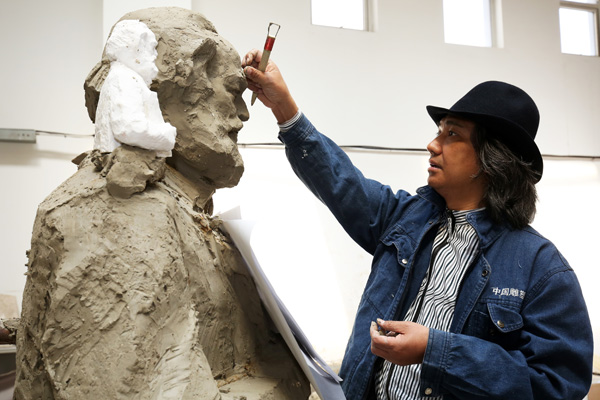A tribute to trier
 0 Comment(s)
0 Comment(s) Print
Print E-mail China Daily, May 4, 2018
E-mail China Daily, May 4, 2018
Karl Marx's statue in his hometown infuses philosopher's soul with art, writes its sculptor Wu Weishan.

In the history of human civilization, people have erected statues to show their recognition of human values and to celebrate men of special significance.
Thus, Western history can be read through sculptures, which aren't just about aesthetic appreciation but also have cultural and epochal value.
On the 200th anniversary of Karl Marx's birth, a bronze statue of Marx, at a height of 5.5 meters, will find its home in a public square in Trier, Germany, Marx's hometown on Saturday.
The statue also reflects the city's profound historical and cultural traditions.
As the sculptor of the bronze statue, I'm proud that its appearance in Trier has drawn global attention. As history has entrusted me the mission to infuse the philosopher's soul with art, it is not only about conveying personal style and emotions, but also the friendship between Chinese and Germans.
Recalling the two years of the creating process of the statue arouses waves of emotions in me.
The story began with my trip to Trier in January 2016, with respect and dreams of decades.
As one of the oldest cities in Germany, Trier got fame as early as 2,000 years ago during the Roman times. The river Moselle slowly winds through, reflecting the city's elegance and primitive simplicity. The red sandstone hills and warm purple forests under the winter sunshine echo with Roman architecture, whose poetic tone reminds me of the early Renaissance oil paintings.
Having witnessed numerous pedestrians coming and going for thousands of years, the stone roads are burnished with sheen. The holy melody of the church organs and the slow rhythm of life tell the city's long history. All of these are filled with the historical and cultural profoundness of the great man's birthplace.
Wolfram Leibe, the Lord Mayor, Andreas Ludwig, the director of the city's planning department, and all the citizens I saw were in high spirits.
At Karl Marx House, the former residence of Marx, I sensed why a member of the lawyer family was born with the genes of reason and logic. Marx had spent his childhood and a part of his teenage life in Trier before he went to the University of Bonn at the age of 17, and later studied law at the University of Berlin, where he was fascinated by philosophy and history.
Step by step, he walked toward the forefront of European culture and then made his way into the world.
That was when I came up with the concept of the Marx statue. Accompanied by the mayor, we went to the designated location of the statue. Knowing that the city has invited a Chinese artist for the statue, some of my German peers had come from Berlin. And, a number of journalists, citizen representatives and role-players of Marx were there, too.
In Germany, it requires social participation, repeated public discussions in media and a vote through parliament to build a statue in public spaces.
Facing the media and the public, I talked about Marx's commitment to the dedication of happiness for all, his perseverance in search for the truth, his calmness when overcoming adversity in his life, as well as his optimism and confidence for enriching his life. Marx had been voted "the greatest thinker of the millennium" by BBC News Online readers and topped several lists of the greatest philosophers in history, which made Germany proud.
For a century Chinese society has achieved great progress by combining Marxism with Chinese social realities.
In that sense, a Marx statue by a Chinese sculptor will become a bond of friendship between China and Germany.
As a Chinese artist, I grew up with a portrait of Marx at home. His iconic hairstyle and moustache, as well as the thoughtful expressions had found their way to my heart and soul.
Images of a man change according to different stages in his life. As the first large outdoor sculpture of the city, I intended to conform it to Marx's identity as a great thinker and philosopher and meanwhile apply an image that had represented Chinese people's impression of him.






Go to Forum >>0 Comment(s)